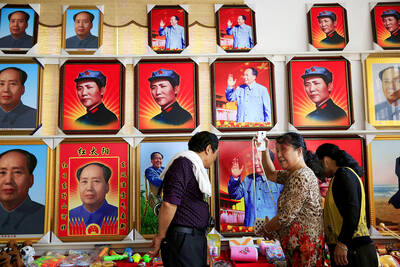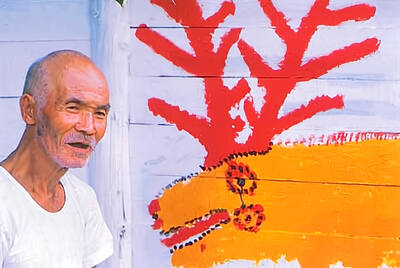After the success of its first full-length album, Pacu’s Trip, an eclectic mix of African drumming, Middle Eastern melodies, Aboriginal sounds and a little cabaret — which the Taipei Times called one of the top 10 local albums of 2004 — A Moving Sound is set to release its second CD, Songs Beyond Words, at Harris Conference Hall (寶環國際會議廳) tomorrow at 7:30pm.
The brainchild of Scott Prairie and Mia Hsieh (謝韻雅) — collaborators in music as well as life — Songs Beyond Words has seen the duo take their oeuvre in a different, more serious direction.
“There is definitely a choice to become more Asian. The first CD was more diverse in exploring different idioms, [where] the energy was free and joyful,” Hsieh said.

PHOTO COURTESY OF A MOVING SOUND
This album is a guide to that journey. Hsieh said the pair used “the range of things … you find in Taiwan, which could be Aboriginal, nanguan or instruments … influenced by the kuching, an ancient stringed instrument that is used for meditation.”
With its roots flowing back to the Tang Dynasty, nanguan or “southern pipe” is a traditional musical genre originating from China’s Fujian Province. It features singing that is delicate and flowing and music from specially made string instruments.
The kuchin is one of China’s oldest and most revered stringed instruments; its meditative character serves as a symbol of the CD’s inspiration.
“You can say [kuching and nanguan], which are originally from China, are well-preserved in Taiwan,” Hsieh said.
Since the pair have worked together in Taiwan for more than four years, a deeper exploration of local music was inevitable. For Song Beyond Words (心的航行) the couple teamed up with Grammy-nominated designer Xiao Qing-yang (蕭青陽) of Shout Design Studios to produce the album artwork.
They also enlisted an all-star cast of musicians, including Wu Alex Wu (吳政君) on percussion, flute and erhu and Lo Tang-Hsuan (羅堂軒) who also plays the erhu, a two-stringed traditional Chinese instrument. Both are graduates of Taiwan’s Chinese Traditional Music College.
Rounding out the group is Hsieh Hua-chou (謝華洲), a well-respected musician in Taiwan’s jazz circles, who plays the zhong ruan (中阮), a Chinese guitar-like instrument that evolved from the Arabic four stringed oud. He also plays the Western guitar.
Because of their extensive training in traditional Chinese music, Prairie and Hsieh gave the musicians a considerable amount of freedom to explore their own ideas.
“The musicians composed a lot of their own solo parts. So we kind of started from different places and ended up together,” Hsieh said.
“The way it connects, the music, it comes from an internal, a very inward way of creating,” Prairie said. “Finding a big open empty place inside yourself, and letting something come out of it.”
Prairie and Hsieh pointed out that the connection to traditional Chinese musical culture is not done to create a copy of history but to offer a re-creation of a deep historical experience. When ancient instruments, ancient melodies and ancient spirits meet across time and space, “we find the same nature and the same timeless, universal expression of life.”
“We tried to focus on this musical direction. You hear it first from Taiwan’s night market, which is my impression of Taiwan’s energy. Then the songs travel to China [and through] the Tang Dynasty, to the Silk Road, to a distant time in Asia. There is a clear line there,” Hsieh said.
The song Silk Road is a celebration of the cultural, economic, and religious exchanges between East and West that date back thousands of years and connects the Qin Dynasty to ancient Rome. And like travelers before them, Prairie and Hsieh see themselves following in this ancient tradition.
As the album’s title suggests, the music, as a form of expression, takes precedence over the lyrics. Only three songs on the album use spoken words.
Having studied under some pioneering experimental improvisational vocalists, including Meredith Monk in New York, Hsieh applies avant-garde techniques to her songs. Reflecting the roots of her past, the song Ku Chin is sung in an ancient Taiwanese dialect and in Ghost Lake she sings in an Aboriginal dialect.
“When people hear my voice they think it’s [a combination of] ancient and avant-garde,” says Hsieh.
The couple spent two years getting this project off the ground. With their first album their sights were set on the local market. But as their musical range has become more focused on Asian musical styles, they are trying to move beyond the local market and into the realm of World Music.
“Our sights are on the international market,” Prairie said.
And what about the approach record companies in Taiwan take towards independent music?
“Lets just say that the scene in is evolving,” Prairie said. “The CD companies only helped us with distribution.
“As the producers of the CD, we paid the money for everything. We printed them. We paid all the money for recording, design; we produced everything.”
Hsieh added: “Independent production is becoming more [common]. I think the whole environment of record companies is very hard. And with all this recording skill and technique and computers — it helps people to do it themselves. It’s the same in Taiwan.”

The ultimate goal of the Chinese Communist Party (CCP) is the total and overwhelming domination of everything within the sphere of what it considers China and deems as theirs. All decision-making by the CCP must be understood through that lens. Any decision made is to entrench — or ideally expand that power. They are fiercely hostile to anything that weakens or compromises their control of “China.” By design, they will stop at nothing to ensure that there is no distinction between the CCP and the Chinese nation, people, culture, civilization, religion, economy, property, military or government — they are all subsidiary

It’s always a pleasure to see something one has long advocated slowly become reality. The late August visit of a delegation to the Philippines led by Deputy Minister of Agriculture Huang Chao-ching (黃昭欽), Chair of Chinese International Economic Cooperation Association Joseph Lyu (呂桔誠) and US-Taiwan Business Council vice president, Lotta Danielsson, was yet another example of how the two nations are drawing closer together. The security threat from the People’s Republic of China (PRC), along with their complementary economies, is finally fostering growth in ties. Interestingly, officials from both sides often refer to a shared Austronesian heritage when arguing for

Nov.10 to Nov.16 As he moved a large stone that had fallen from a truck near his field, 65-year-old Lin Yuan (林淵) felt a sudden urge. He fetched his tools and began to carve. The recently retired farmer had been feeling restless after a lifetime of hard labor in Yuchi Township (魚池), Nantou County. His first piece, Stone Fairy Maiden (石仙姑), completed in 1977, was reportedly a representation of his late wife. This version of how Lin began his late-life art career is recorded in Nantou County historian Teng Hsiang-yang’s (鄧相揚) 2009 biography of him. His expressive work eventually caught the attention

Late last month the Executive Yuan approved a proposal from the Ministry of Labor to allow the hospitality industry to recruit mid-level migrant workers. The industry, surveys said, was short 6,600 laborers. In reality, it is already heavily using illegal foreign workers — foreign wives of foreign residents who cannot work, runaways and illegally moonlighting factory workers. The proposal thus merely legalizes what already exists. The government could generate a similar legal labor supply simply by legalizing moonlighting and permitting spouses of legal residents to work legally on their current visa. But after 30 years of advocating for that reform,